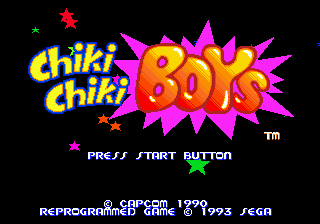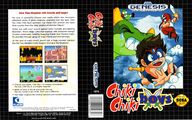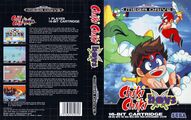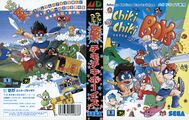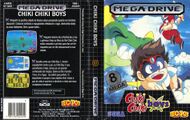Chiki Chiki Boys
From Sega Retro
| This article needs to be rewritten to de-Sonic Retro-ize. This article needs to be rewritten to conform to a higher standard of article quality. After the article has been rewritten, you may remove this message. For help, see the How to Edit a Page article. |
| Chiki Chiki Boys | |||||
|---|---|---|---|---|---|
| System(s): Sega Mega Drive | |||||
| Publisher: Sega | |||||
| Developer: Capcom Sega, Visco (sound) | |||||
| Sound driver: Visco/Kazuo Okabayashi | |||||
| Genre: Action | |||||
|
Chiki Chiki Boys (チキチキボーイズ), also known as Mega Twins in some areas, is an arcade game by Capcom first released in 1990 and ported to the Sega Mega Drive in 1992 by Sega and Visco. The game features two twins who are attempting to re-take control of their land, Alurea, after a monster unexpectedly attacks, destroying everything in its path. The people of Alurea have lived in peace for a thousand years and have forgotten how to fight, yet the land's only survivors, the twin sons of the king, must take up the challenge and return their kingdom to its former glory.
The two twins, aged around 15 at the time the game takes place, venture forth in search of a legendary stone known as "Dragon Blue Eyes," which is rumoured to be able to put everything back to rights.
The game is notable in the Sonic scene for its Mega Drive version; the Sonic 2 Simon Wai prototype contains some leftover graphics from the game once thought to be part of Sonic 2. The ROM is believed to have been dumped from a cart which originally had Chiki Chiki Boys before being overwritten with the Sonic 2 prototype ROM.
Contents
Game mechanics
The game takes the form of a scrolling platform/beat 'em up game, with the players controlling the characters of the twins. The game can be played alone (in which case only one of the twins is present), or with two players together controlling one twin each.
In addition to moving around, the players can jump (![]() ) and also cling on to vertical walls, allowing them to climb to areas that would otherwise be out of reach. Each player is armed with a magic sword (
) and also cling on to vertical walls, allowing them to climb to areas that would otherwise be out of reach. Each player is armed with a magic sword (![]() ), which is the main weapon used against the enemies in the game. Magic bombs can also be collected as the game progresses, each of which will cause damage to all enemies on the screen when fired (
), which is the main weapon used against the enemies in the game. Magic bombs can also be collected as the game progresses, each of which will cause damage to all enemies on the screen when fired (![]() ). Only a limited number of these bombs can be carried by the players at a time.
). Only a limited number of these bombs can be carried by the players at a time.
Each player has an energy bar which is depleted each time contact is made with an enemy or projectile. When the energy reaches zero, the player loses a life.
Chests are scattered throughout the game (some of which are hidden and must be discovered), the majority of which contain coins that add point to the players' scores, but some of them contain power ups and bonuses such as a pill that replenishes the players' energy bars and an enhanced magic sword.
Levels
The game is made up from nine levels, which are as follows:
- Round 1 - the earth—consisting of a forest section and a lava-filled cavern. The goddess Callia is encountered at the end of this level.
- Round 2 - the heavens—at the end, the Shrine of Meius, the god of the heavens, is reached.
- Round 3 - under the sea—during which the twins travel through a haunted sunken pirate ship.
- Round 4 stage 1 - jungle/crystal caverns.
- Round 4 stage 2 - the underwater foundations.
- Round 4 stage 3 - the monster castle dungeon.
- Round 4 stage 4 - into the sky.
- Round 4 stage 5 - ascent to the top of monster castle.
- Round 5 - escape to paradise.
The player is able to select to start on any of the first three levels, but the remaining levels can only be accessed sequentially.
Ports
- U.S. Gold released ports of Mega Twins for the Atari ST and Commodore Amiga in 1991. Ports for the Commodore 64, ZX Spectrum and Amstrad CPC were advertised, but were never published.[1]
- A Mega Drive/Genesis port of the game was released by Sega in 1992. This port was released in North America and Europe under the game's original Japanese title of Chiki Chiki Boys.
- A PC Engine port in Super CD-ROM format was released in 1994 in Japan only by NEC Avenue.
- The game is included in Capcom Classics Collection: Remixed for the PlayStation Portable, and Capcom Classics Collection Volume 2 for PlayStation 2 and Xbox, both released in 2006.
Production Credits
The Original Crew
Game Design: Bully Duck
Director: Poo, Kihaji
Object Design: Manbou, Ikusan Z, Unicorn Mayumi
Scroll Design: Zummy & Ziggy
Sound Design: Hifumi
Hard Design: Kuccan
Special Thanks: Ozzy, Kame, Satochin, Genie
Programming: Blbon, Meijin, Saikou Yuki
The Mega Drive Crew
Graphic Design: Minoyan, Banana
Sound Arrange: Junchan
Support: Sakura, Kineo, Ozuka Akuzo, Zin Ryu
Special Thanks: Ohno chan, Chiki Room
Programming: Winza
Physical Scans
| 71 | |
|---|---|
| Based on 35 reviews | |
| Mega Drive, AU |
|---|
|
- ↑ File:SegaForce16UK.pdf, page 40
- ↑ 1700 igr dlya Sega, "" (RU; 2001-xx-xx), page 47
- ↑ Aktueller Software Markt, "August 1993" (DE; 1993-07-12), page 41
- ↑ Beep! MegaDrive, "October 1992" (JP; 1992-09-08), page 23
- ↑ Consoles +, "Janvier 1993" (FR; 199x-xx-xx), page 108
- ↑ Computer & Video Games, "June 1993" (UK; 1993-05-15), page 97
- ↑ Mean Machines: The Essential Sega Guide, "" (UK; 1993-11-18), page 31
- ↑ Famitsu, "1992-10-09" (JP; 1992-09-25), page 39
- ↑ GameFan, "Volume 1, Issue 2: December 1992" (US; 1992-xx-xx), page 9
- ↑ Gamers, "Dezember/Januar 1993" (DE; 1992-11-19), page 96
- ↑ Hippon Super, "November 1992" (JP; 1992-10-03), page 46
- ↑ Joypad, "Décembre 1992" (FR; 1992-1x-xx), page 102
- ↑ Joypad, "Avril 1993" (FR; 1993-0x-xx), page 159
- ↑ Joystick, "Décembre 1992" (FR; 1992-1x-xx), page 167
- ↑ Sega Mega Drive Advanced Gaming, "April 1993" (UK; 1993-xx-xx), page 60
- ↑ Mega, "January 1993" (UK; 1992-12-17), page 57
- ↑ Mega Action, "June 1993" (UK; 1993-05-20), page 47
- ↑ Mega Force, "Avril 1993" (FR; 1993-0x-xx), page 82
- ↑ Mega Fun, "06/93" (DE; 1993-05-19), page 41
- ↑ MegaTech, "January 1993" (UK; 1992-12-20), page 70
- ↑ Micromanía (segunda época), "Abril 1993" (ES; 1993-0x-xx), page 44
- ↑ Marukatsu Mega Drive, "November 1992" (JP; 1992-10-xx), page 107
- ↑ Mean Machines Sega, "January 1993" (UK; 1992-12-28), page 50
- ↑ Player One, "Avril/Mai 1993" (FR; 1993-04-10), page 60
- ↑ Play Time, "4/93" (DE; 1993-03-10), page 112
- ↑ Power Up!, "Saturday, May 08, 1993" (UK; 1993-05-08), page 1
- ↑ Power Unlimited, "Nummer 1, Juli 1993" (NL; 1993-0x-xx), page 38
- ↑ Sega Power, "February 1993" (UK; 1993-01-07), page 46
- ↑ Sega Pro, "February 1993" (UK; 1993-01-14), page 56
- ↑ Sega Pro, "April 1993" (UK; 1993-03-11), page 64
- ↑ Sega Zone, "January 1993" (UK; 1992-12-xx), page 56
- ↑ Sega Force, "April 1993" (UK; 1993-03-04), page 40
- ↑ Sega Saturn Magazine, "September 1995" (JP; 1995-08-08), page 85
- ↑ Todo Sega, "Abril 1993" (ES; 1993-03-15), page 26
- ↑ Tricks 16 bit, "Tricks Sega Gold 800 igr" (RU; 1998-03-20), page 43
- ↑ Video Games, "1/93" (DE; 1992-12-16), page 57
- Pages Needing to be Rewritten
- No players field
- Use romtable template
- All games
- Old-style rating (consolesplus)
- Old-style rating (cvg)
- Rating without PDF source
- Old-style rating (gamefan)
- Rating without source
- Old-style rating (joypad)
- Old-style rating (joystick)
- Old-style rating (mdag)
- Old-style rating (mega)
- Old-style rating (megaaction)
- Old-style rating (megatech)
- Old-style rating (mms)
- Old-style rating (playerone)
- Old-style rating (pu)
- Old-style rating (segapower)
- Old-style rating (segapro)
- Old-style rating (segazuk)
- Old-style rating (sfuk)
- Use magref
- Update ratings template
- 17 old ratings
